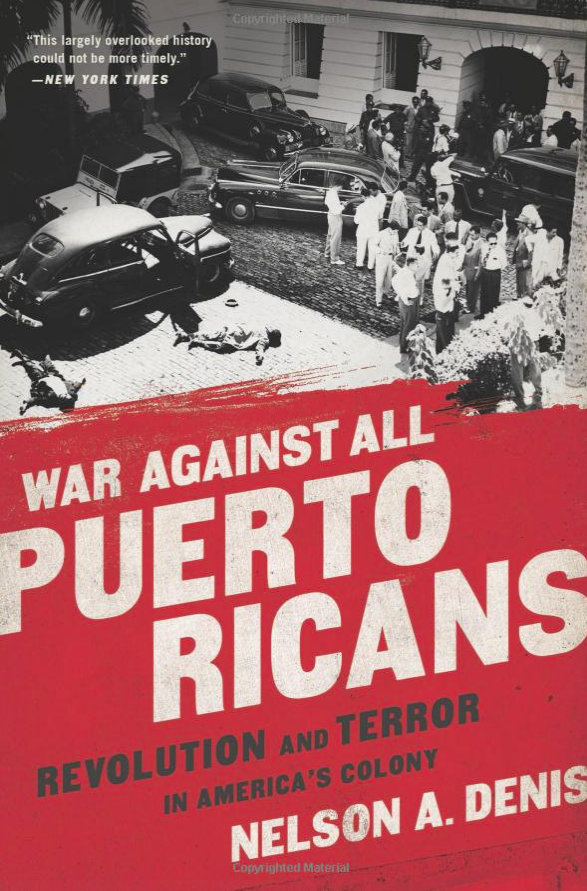FEW of us could point out Puerto Rico on a map of the world but fewer still are aware that this tiny Caribbean island, now a US territory, once boasted an independence movement which collaborated with De Valera. That gap in our knowledge has now been put right with the the timely publication of the powerful ‘War Against All Puerto Ricans: Revolution and Terror in America’s Colony’ by accomplished journalist Nelson A. Denis.
His book sweeps through the many humiliations heaped on Puerto Ricans after the US invasion of 1898, such as a ban on Spanish in schools and a prohibition against the flying of the nation’s flag.
Where the American government led, business followed. Suffocating poverty on the island and slave-like conditions on the sugar plantations worsened. The first civilian governor Charles Allen returned to the US and leveraged his contacts and influence to become the King of Sugar.
“By 1930,” writes Denis, “Allen and US banking interests had converted 45 per cent of all arable land in Puerto Rico into sugar plantations. These bank syndicates also owned the insular postal system, the entire coastal railroad, and the international seaport of San Juan.”
Patriots responded with their own Nationalist Party but its ranks were riddled with FBI informers and when that didn’t stymie its growth, supporters were massacred in the town of Ponce. On Sunday March 21 1937, a parade of unarmed nationalist cadets was effectively ambushed by police in scenes similar to our own Bloody Sunday.
“The police kept shooting and clubbing for thirteen minutes,” says Denis. “By the time they finished, 19 men, one woman and a seven-year-old girl lay dead; over 200 more were gravely wounded — moaning, crawling, bleeding, and begging for mercy in the street."
1950 marked the high-point of this revolutionary rising when, following 50 years of military occupation, the Nationalist Party of Puerto Rico staged an unsuccessful armed insurrection.
They paid a heavy price for tweaking the tale of the tiger. Ill-trained and poorly-equipped cadres of nationalists – branded communists by the powers-that-be – were cut down by US National Guard troops. In the town of Jayuya where revolutionaries had seized control, the residents were subjected to a merciless bombardment by ten Thunderbolt fighter planes armed with 500-lb bombs. It was the only time in history that the United States bombed its own citizens.
Within a fortnight, the rebellion had been quashed but not before a failed assassination attempt on President Truman had ensured the tiny island nation’s freedom struggle made headlines around the world.
The nationalists paid a heavy price: vengeful prison sentences were meted out to the leaders and activists. One woman, Blanca Canales, served 17 years of a life sentence for burning the post office in Jayuya — the same town levelled by US planes. Their incarcerated leader Pedro Albizu Campos was subject to brutal conditions right out of the Gulag Archipelago — and then some. In 1951, he was exposed to radiation poisoning which led to visible burns on his extremities, swelling of his face and led to a stroke which left him paralysed. Thus ended the long struggle of the revolutionary who had parlayed with De Valera and raised money for the Irish liberation movement in Boston in 1919 — at one point he spoke in front of 1,400 people in Sanders Theatre in Boston and delivered what was described, by an English lord no less who was present, as “the most complete, the most brilliant speech” on Irish freedom ever heard.
The 50 years which followed his death in 1965 were, says Denis, “a downward spiral of chaos and corruption that turned the island into a punch-drunk fighter, unsure of its whereabouts, wobbling on its feet, pawing at empty air”.
It’s hard to argue that things have improved of late. Emigration is the only route to meaningful work for an entire generation: In 2011 alone, it lost a net 54,000 residents or nearly 1.5 per cent of its population.
In 2017, the island went bankrupt with the US Government refusing to come to its aid. In 2017, Puerto Rico was hammered by a Hurricane Maria — the worst natural disaster to ever hit the island.
“Is there a solution to all this?” asks Denis. “Of course, but the complicated ones rarely work. Those that have been tried include corporate tax subsidies to giant pharmaceutical companies, a fraudulent war on drugs, government subsidies, austerity programmes, and real estate speculation. These ‘solutions’ breed government fraud, police corruption, absentee ownership, junk bonds, media spin, and rampant hotels, shopping malls and parking lots. The answer may be much simpler. It starts with an honest self-appraisal. It acknowledges the eviction of an entire people — literally and systematically — from their own land.”
Nelson Denis has done a service to the people of Puerto Rico — his people — and to the wider world watching on with this authoritative history of a brave island people. He has, at last, put Puerto Rico on the map.






